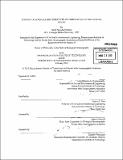Ecology and population structure of vibrionaceae in the coastal ocean
Author(s)
Preheim, Sarah Pacocha
DownloadFull printable version (13.54Mb)
Other Contributors
Woods Hole Oceanographic Institution.
Advisor
Martin F. Polz.
Terms of use
Metadata
Show full item recordAbstract
Extensive genetic diversity has been discovered in the microbial world, yet mechanisms that shape and maintain this diversity remain poorly understood. This thesis investigates to what extent populations of the gamma-proteobacterial family, Vibrionaceae, are ecologically specialized by investigating the distribution across a wide range of environmental categories, such as marine invertebrates or particles in the water column. Additionally, it seeks to determine whether in situ population distributions directly result from a competitive advantage over other Vibrio populations. This was investigated by in vitro competition assays on mixtures of native, sterilized particles. Generalist populations were found to dominate the associations with marine invertebrates, consistent with a model of high migration dominated population assembly. A majority of populations occurred broadly within and among the different types of invertebrates sampled, with one population being a near perfect generalist with regard to seasons, host taxa and body regions. High variability across host individuals, consistent with a scenario of stochastic clonal expansion, was especially pronounced in crab and zooplankton samples. Specialization, demonstrated by specific and reproducible association with different particle types in the water column, is more common than specialization within invertebrate hosts. (cont.) Co-existing Vibrio species show strong preferences for different types of particulate matter in the water column suggesting that competition for limited resources influences their evolution. While populations show different growth profiles on particle derived substrates, relative growth advantages of specialist populations in competition with other Vibrio populations on native particles may not be sufficient to explain observed environmental distributions. Instead, populations may gain an advantage on these particles by colonizing the living plant or zooplankton prior to death and degradation into particulate matter. In summary, although vibrios are known commensals of marine invertebrates, evidence suggests that population structure within animals is fairly weak compared to suspended particles in the water column. This highlights the importance of comparing multiple environmental categories and migration among them to investigate population structure and adaptation.
Description
Thesis (Ph.D.)--Joint Program in Oceanography (Massachusetts Institute of Technology, Dept. of Civil and Environmental Engineering; and the Woods Hole Oceanographic Institution), 2010. Cataloged from PDF version of thesis. Includes bibliographical references.
Date issued
2010Department
Joint Program in Oceanography; Woods Hole Oceanographic Institution; Massachusetts Institute of Technology. Department of Civil and Environmental EngineeringPublisher
Massachusetts Institute of Technology
Keywords
Joint Program in Oceanography., Civil and Environmental Engineering., Woods Hole Oceanographic Institution.